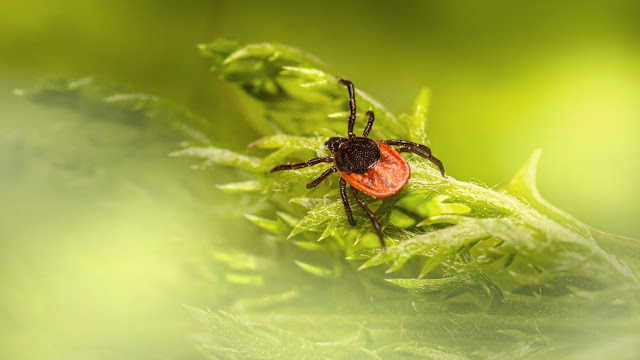Babesiosis, a tick-borne ailment that may be deadly in uncommon instances, is turning into greater established withinside the Northeast, the Centers for Disease Control and Prevention stated in a record launched Thursday.
The findings display that some of the 10 states that mentioned babesiosis instances from 2011 to 2019, 8 noticed their numbers upward push, at the same time as simply two — Minnesota and Wisconsin — discovered declines.
What`s greater, babesiosis in now taken into consideration endemic in 3 new states: Maine, New Hampshire and Vermont. Previously, the ailment changed into taken into consideration endemic simplest in Connecticut, Massachusetts, Minnesota, New Jersey, New York, Rhode Island and Wisconsin.
"Nine years of facts display [an] boom in tickborne ailment in components of the U.S. that formerly noticed few instances," stated Megan Swanson, an epidemiologist with the CDC`s Division of Parasitic Diseases and Malaria, who co-authored the record.
Symptoms of babesiosis consist of fever, chills, sweats, headaches, frame aches, nausea, fatigue or muscle and joint pain. The ailment has an usual fatality charge of round 1% to 2%, in keeping with Dr. Peter Krause, a senior studies scientist on the Yale School of Public Health, who wasn`t worried withinside the CDC study.
Up to 20% of grownup instances and 50% of pediatric instances are asymptomatic. Older or immunocompromised humans are maximum liable to intense results like low blood platelet counts, kidney failure or acute respiration misery syndrome, wherein fluid builds up withinside the lungs.
The record highlights “an unlucky milestone withinside the emergence of babesiosis withinside the United States,” Krause stated. “More instances method greater infection, and actually, a few humans die.”
Babesiosis may be greater intense than Lyme ailment
Humans in large part collect babesiosis from deer ticks, whose bites can transmit Babesia parasites that infect pink blood cells.
Most transmission happens from overdue May to early September. Researchers assume that as weather extrade drives longer durations of humidity, it creates greater hospitable environments for ticks.
“The ticks are surviving higher withinside the winter, and so the subsequent spring, you've got got greater ticks to chunk greater humans,” stated Edouard Vannier, an assistant professor who research babesiosis at Tufts Medical Center in Boston and wasn`t worried withinside the record.
The new facts indicates that the wide variety of babesiosis instances rose 17-fold in Vermont and greater than 34-fold in Maine from 2011 to 2019.
Babesiosis can every so often be stressed with Lyme ailment, every other tick-borne infection that reasons fever and muscle aches. Whereas Lyme ailment has a defining feature — a rash on the webweb page of the tick chunk — Krause stated there isn`t an apparent babesiosis symptom. It's normally identified via way of means of a blood test.
“Sometimes the affected person could have felt simply fatigued and now no longer pretty right, perhaps a low-grade temp for per week or two, after which all of a surprising they get worse,” Krause stated. “That`s normally now no longer the case with Lyme — you get it after which, bingo, you've got got the rash and so on.”
Babesiosis has a tendency to be greater intense than Lyme ailment, even though Lyme is a long way greater common. The CDC statistics round 30,000 instances of Lyme ailment each year, while round 16,500 general instances of babesiosis had been recorded from 2011 to 2019.
People can get each illnesses at once, Vannier stated. He predicted that 1/2 of of humans with babesiosis additionally have Lyme ailment.
A upward push in tick-borne ailment
Scientists recognized the primary human case of babesiosis withinside the U.S. in 1969. Its growing occurrence has coincided with an usual upward push in tick-borne ailment, which rose via way of means of 25% from 2011 to 2019. From 1999 to 2019, showed instances of Lyme ailment rose via way of means of 44%.
Researchers characteristic the fashion to three factors. For one, deer populations have expanded, giving ticks greater possibilities to feed and reproduce. People also are more and more more travelling to and constructing houses in forested areas.
On pinnacle of that, growing international temperatures have led to longer summers and shorter winters, and ticks thrive in warm, humid climates.
Krause additionally stated that older humans have come to symbolize a bigger proportion of the populace and stated they're greater liable to intense babesiosis and consequently much more likely to get reliable diagnoses.
“It has a tendency to be the greater intense instances, those that get into the hospital, which are mentioned," he stated.
The CDC record encouraged that folks who spend time exterior in states in which babesiosis is endemic put on lengthy pants, use tick repellant and keep away from underbrush and lengthy grass.
Researchers stated babesiosis is maximum in all likelihood greater established than the CDC depend suggests, thinking of asymptomatic infections and for the reason that now no longer all physicians flag instances to kingdom fitness departments and now no longer all states record instances to the CDC.
“Babesia is tons greater of a hassle than the overall public acknowledges and may be deadly — as much as 20% — in humans who've HIV/AIDS or intense most cancers with chemotherapy or people who lack a spleen,” Krause stated.




.jpg)

.jpg)








0 Comments